Don’t let your company get caught off guard by CVSA Operation Safe Driver Week, July 13th to July 19th, 2025!
Shippers and carriers, mark your calendars! Operation Safe Driver Week is approaching. While this annual event is designed to make our roadways safer, it’s also a crucial week for those in logistics. This pivotal time can impact operational efficiency for shippers and carriers alike. To be prepared, it’s important for all those involved in shipping freight to understand what Operation Safe Driver Week entails and its effect on the freight market.
- What is the CVSA?
- What is Operation Safe Driver Week?
- Impact on Shippers
- Impact on Carriers
- How Shippers Can Prepare
- How Carriers Can Prepare
- Let’s Work Together
What is the CVSA? What is Operation Safe Driver Week?
The Commercial Vehicle Safety Alliance (CVSA) is a non-profit organization dedicated to improving commercial motor vehicle safety through collaboration between law enforcement, industry stakeholders, and the public sector. In partnership with the Federal Motor Carrier Safety Administration (FMCSA), the CVSA launched the Operation Safe Driver initiative in 2007. The goal of this initiative is to reduce the number of deaths and injuries from crashes involving large trucks, buses, and cars.
This initiative includes an annual event, Operation Safe Driver Week. It aims to improve driver behavior through education and increased enforcement efforts, focusing on unsafe driving behaviors. It takes place across North America, so the U.S., Canada, and Mexico. Unlike the CVSA’s other two initiatives (International Road Check and Brake Safety Week), which solely focus on commercial drivers, this event affects all drivers on the road.
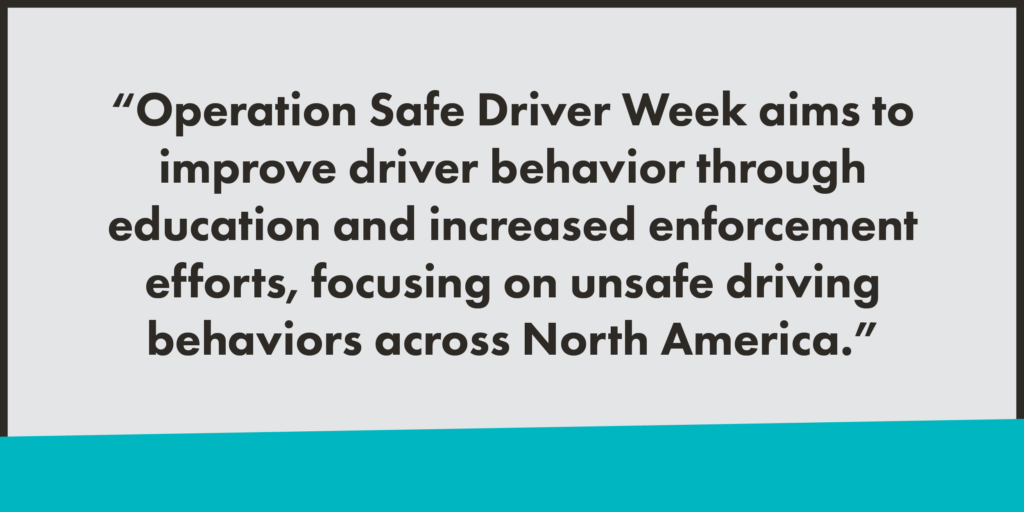
Each year has a primary focus with this year’s being reckless, careless, or dangerous driving. This includes actions like:
- Speeding
- Texting while driving
- Drunk or drugged driving
- Following too closely
- Driving too aggressively
- Improper lane changes
- Failure to obey traffic control devices
- Failing to use a seat belt
Those drivers identified are pulled over by law enforcement and issued warnings or citations.
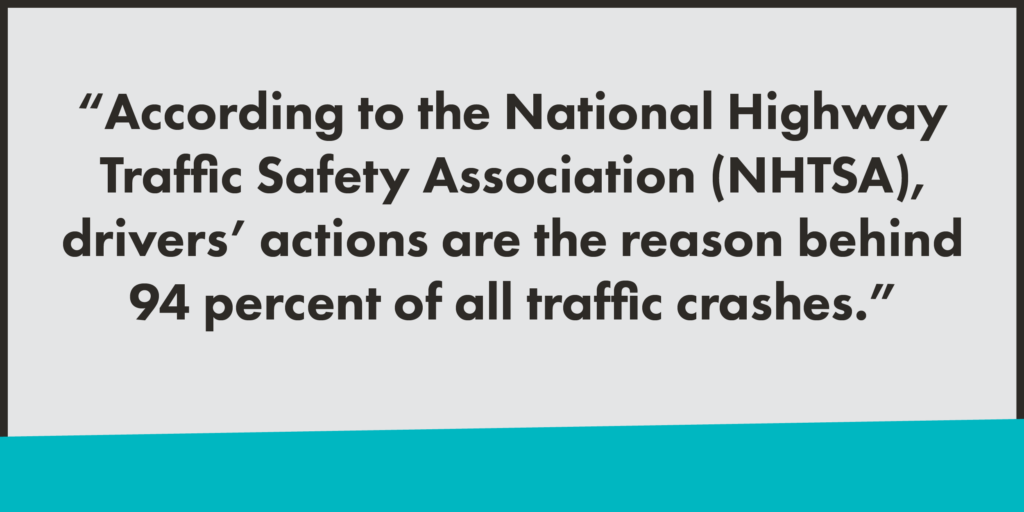
According to the National Highway Traffic Safety Association (NHTSA), drivers’ actions are the reason behind 94 percent of all traffic crashes. Research from the University of Missouri-Columbia has shown that interactions with law enforcement, not just education, are what brings change. During last year’s event, law enforcement interacted with 66,421 drivers! Drivers were informed and educated on how they can improve their driving behavior and do their part in reducing crashes.
Why Should I Be Concerned About Operation Safe Driver Week?
It’s important to be aware of when Operation Safe Driver Week takes place because of the impact it has on shipping freight. Even though it’s just one week out of the year, no one likes to be unprepared for potential disruption or delays to their business.
Operation Safe Driver Week Impact on Shippers
Shippers may face potential delays, see reduced transportation capacity, and likely higher spot rates.
Potential Delays
Increased enforcement activity can lead to potential delays due to any road stop inspections or pullovers.
Reduced Transportation Capacity
The increased enforcement effort sometimes leads carriers to strategically choose to close their business temporarily for the week to avoid any risk of fines or penalties. You might find it more difficult to secure reliable carriers for any last-minute shipments.
Higher Spot Rates
With the potential for fewer trucks available and delays, spot rates can be heightened during this time.
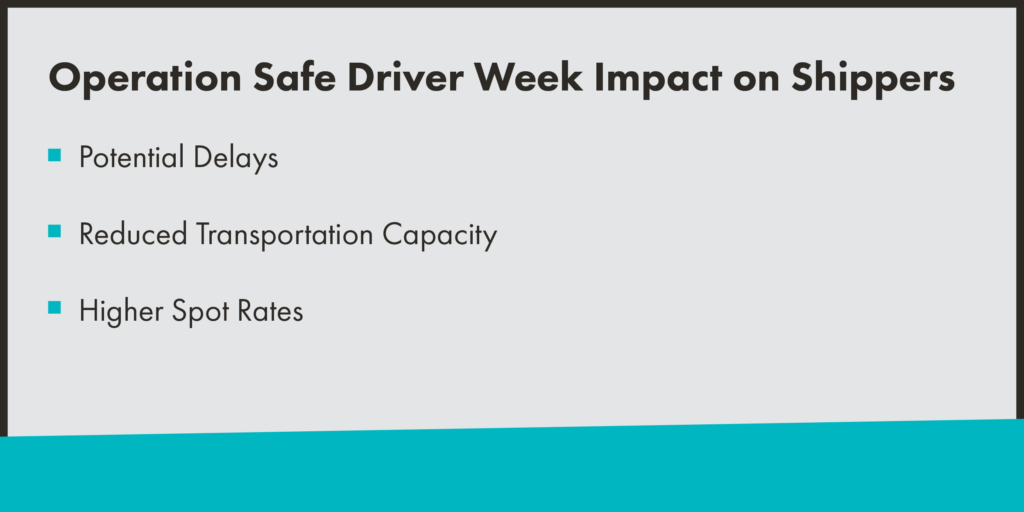
Operation Safe Driver Week Impact on Carriers
Carriers are similarly affected, and there is the potential for delays, less freight volume, and higher scrutiny from law enforcement.
Transportation Delays
Just like shippers, carriers should expect to see potential delays in the movement of traffic due to the increased enforcement. This could disrupt your operations.
Fewer Shipments Available
Shippers may choose to plan around this week, reroute certain shipments, or even look into alternative modes. Less freight may be available during this week.
Increased Law Enforcement
Expect to see increased law enforcement, so more eyes will be looking for unsafe driver behavior, and drivers may receive fines.
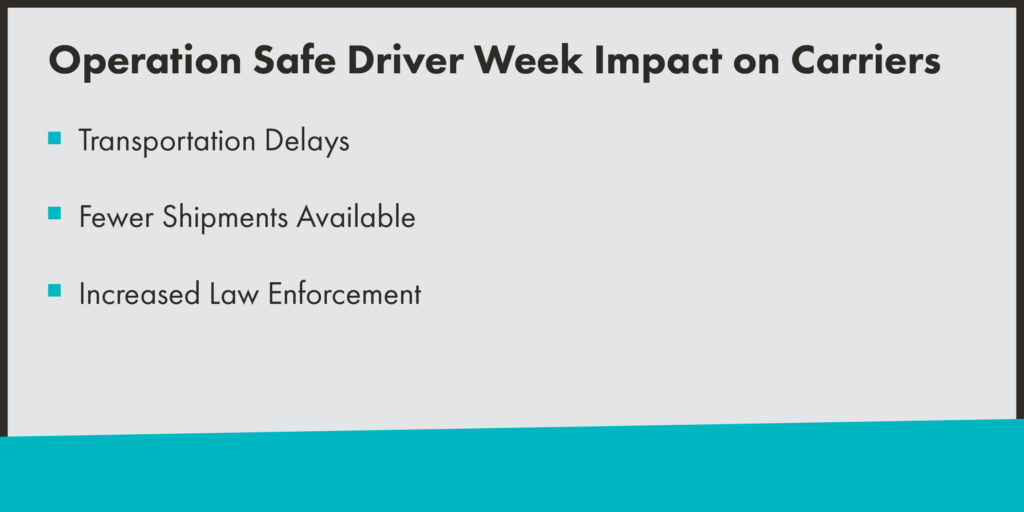
How to Prepare for Operation Safe Driver Week:
Shippers
Ensure Documentation Accuracy
Double-check all shipment documentation. Ensure it is accurate and complete to avoid delays during any unexpected inspections.
Communicate Sensitive Shipment Needs
If you have any special requirements or time sensitivities, communicate this well in advance. This helps your logistics provider plan effectively. Any last-minute communication risks delays.
Find Alternatives
Consider alternative transportation modes or routes if you expect any delays.
Keep Customers Aware
Be proactive and communicate potential delays during this week to your customers to manage expectations.
Share Any Concerns
Discuss any concerns you might have with your logistics provider. They can offer valuable insights and help develop strategies to reduce disruptions.
Pricing Awareness
Be aware of possible higher spot rates during Operation Safe Driver Week. When possible, plan shipments before or after this period to secure better pricing.
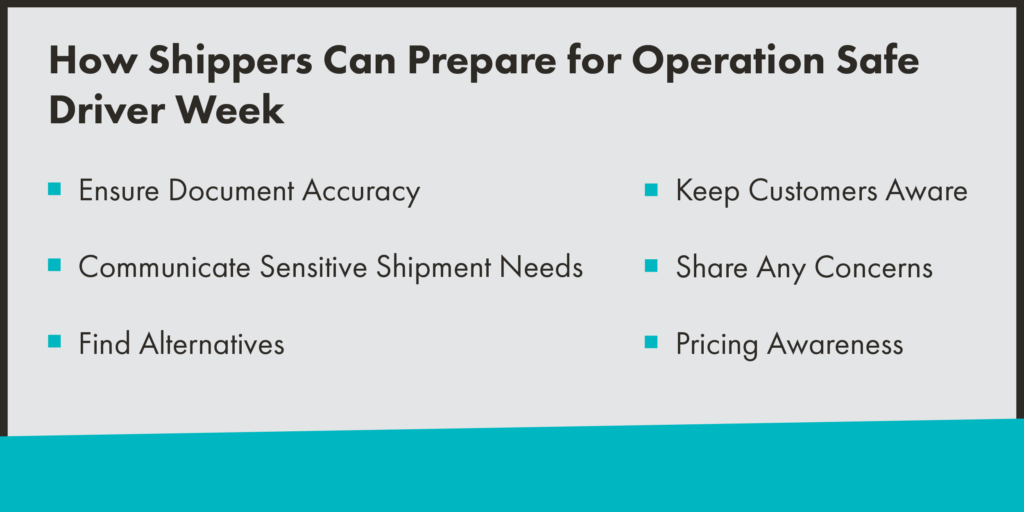
Carriers
Double-Check Credentials
Ensure all company credentials, like operating authority, hazmat endorsements, TWIC cards, and any other relevant permits, are current and accessible.
Driver Documents are Up to Date
Have drivers verify that all paperwork is up to date and accessible in case of inspection.
Vehicle Maintenance Check
Double-check that all vehicles have undergone any necessary preventive maintenance and are in top operating condition to avoid delays due to roadside repairs.
Prep Your Drivers
Make sure drivers are aware of this week and the potential for stops or delays. Train drivers on proper procedures for interacting with law enforcement. Make sure they know the channels to communicate any disruptions to their journey.
Book Ahead
Shippers may choose to reroute shipments, choose alternative modes, or plan around this week. Consider booking shipments well in advance for this week.
Remember – Safety First
The importance of this week is not disruptions but road safety. This is a great time to talk with drivers about safe driving behavior. You could also help educate the public on proper driving behavior when interacting with trucks. Remember, this week benefits everyone who shares the road.
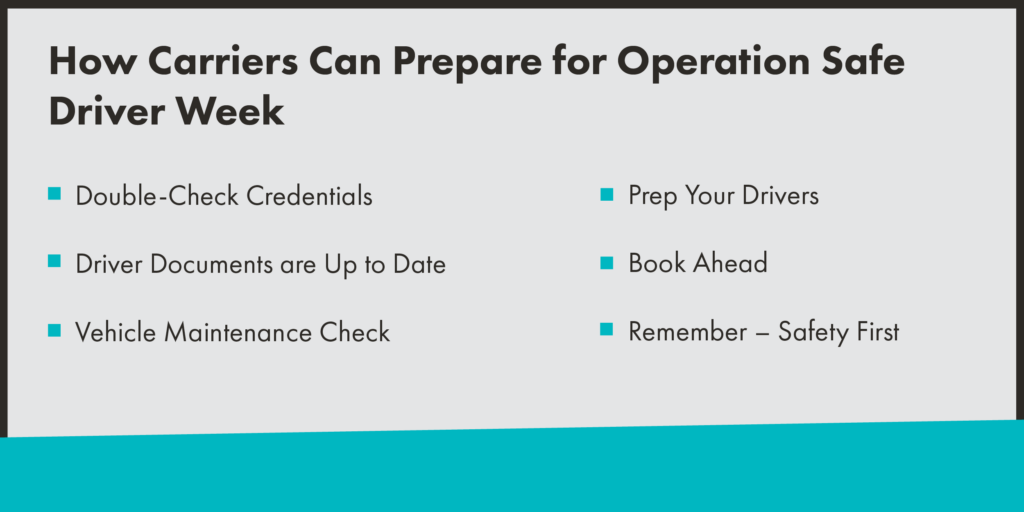
Let’s Work Together to Keep Our Roads Safe
We believe road safety is paramount. While Operation Safe Driver Week might cause some temporary disruptions, it serves a vital purpose in promoting safe driving behaviors.
By staying informed and taking proactive steps, you can likely see minimal effects of Operation Safe Driver Week.
For additional opportunities to stay ahead of disruption to your business during Operation Safe Driver Week, consider working with Trinity Logistics. We have over 45 years of experience helping thousands of shipper and carrier companies conquer more complicated shipping situations, like CVSA inspection weeks. We’re confident in our ability to make this week (and all others) a painless one for your business.

Trinity Logistics, a leading third-party logistics provider (3PL), proudly hosted its first-ever Week of Wonder, an internal initiative designed to spark creativity, collaboration, and problem-solving among its Team Members. Its goal was to empower Team Members across departments to develop forward-thinking solutions aimed at improving Trinity’s operations, customer experience, and service offerings. The event took place from February 24th to the 27th.
Rooted in the Working Genius model, Week of Wonder encouraged Team Members to group up and tap into their individual strengths and collective ingenuity to address and solve real-world logistics challenges. After months of planning and collaboration, finalists presented their concepts to an esteemed panel of judges from the fields of logistics, academia, and technology.
“Innovation isn’t just about big, flashy ideas—it happens at every level, in every role, when people are given the space to think differently,” said Russ Felker, Trinity’s CIO. “Week of Wonder showed that creativity and problem-solving aren’t limited to a single department or title. The energy and collaboration we saw this week is exactly what drives our company and industry forward.”
Meet the Finalists
Out of several teams, three emerged as finalists with solutions focused on improving operational efficiency, fraud prevention, and Carrier relationships:
Trinity CarrierOne Experience
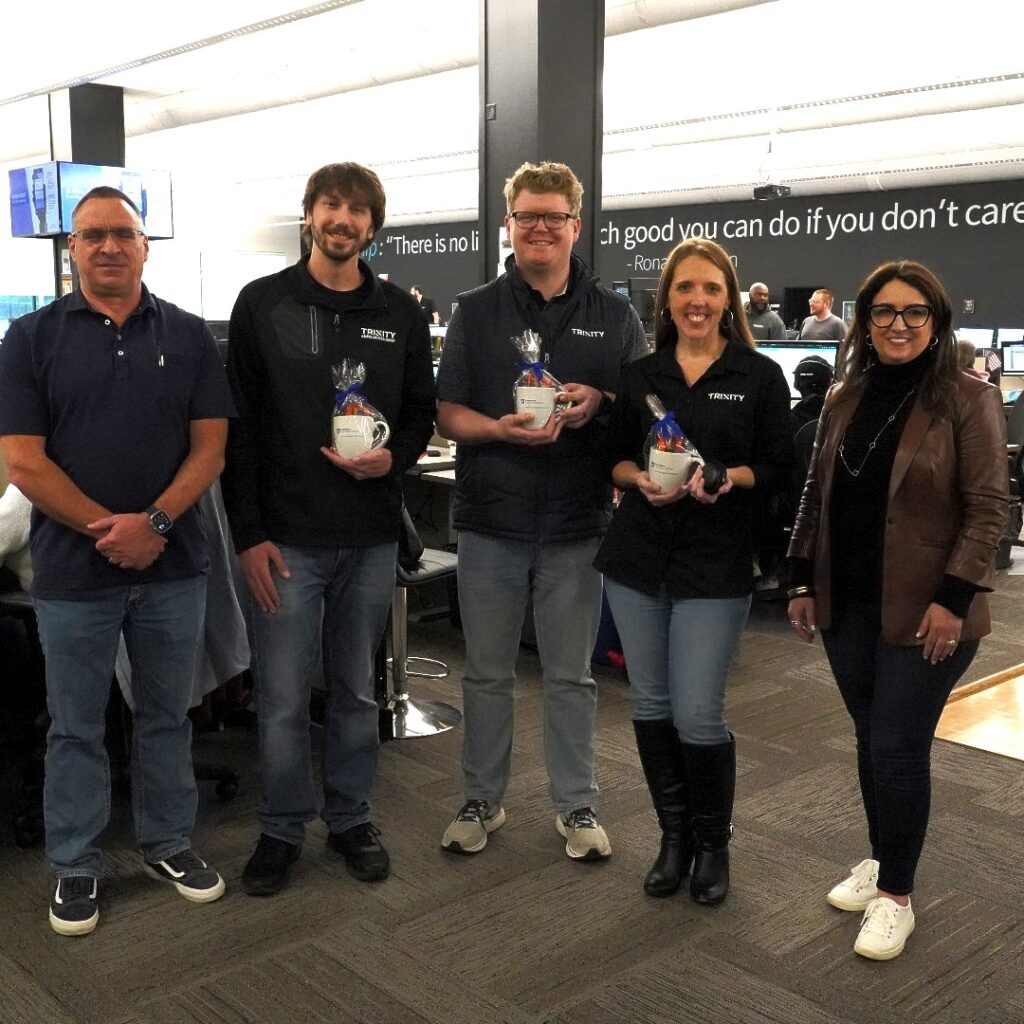
Submitted Pitch: An enhanced Carrier Portal offering Carriers a streamlined, user-friendly space with improved access to key tools.
Team Members: Michael Adams, Amanda Ashford, James Beveridge, and Jessica Clapp
Executive Mentor: Chad Taylor
Fraud Force

Submitted Pitch: A fraud detection and prevention program using advanced technology to protect Carriers and Shippers.
Team Members: Tracy Mitchell, Kristin Deno, and Angela Smith
Executive Mentor: Derek Wise
The Predictive Profits
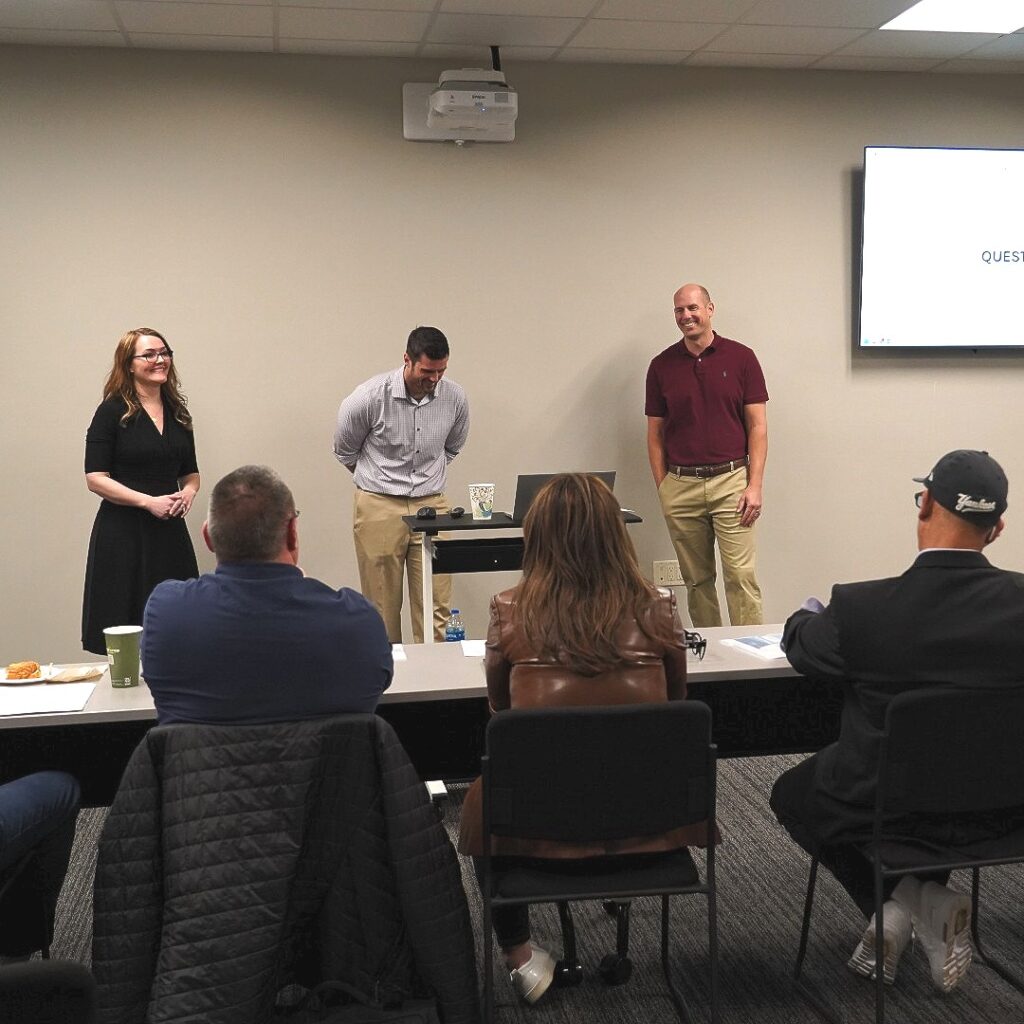
Submitted Pitch: A Carrier grading tool that uses data-driven insights to rank Carriers and enhance routing decisions.
Team Members: Chris McAvoy, Laura Willey, Cheryl Swain, and Zach Howard
Executive Mentor: Greg Massey
After careful deliberation, the Trinity CarrierOne Experience team was crowned the inaugural Week of Wonder winner. Their upgraded Carrier Portal pitch stood out for its immediate usability, long-term scalability, and potential for cross-functional impact.
“Collaborating with Team Members across departments to solve this problem for our Carriers was an exciting experience,” said Amanda Ashford, Analyst II at Trinity and member of the winning team. “By bringing together diverse perspectives and expertise, we created a solution that not only serves Carriers better but also improves experiences for Shippers, Team Members, and our Burris Logistics relationships.”
A Judging Panel of Industry Experts
Finalists presented their innovations to a distinguished panel, who evaluated each concept based on problem relevance, impact, and feasibility:
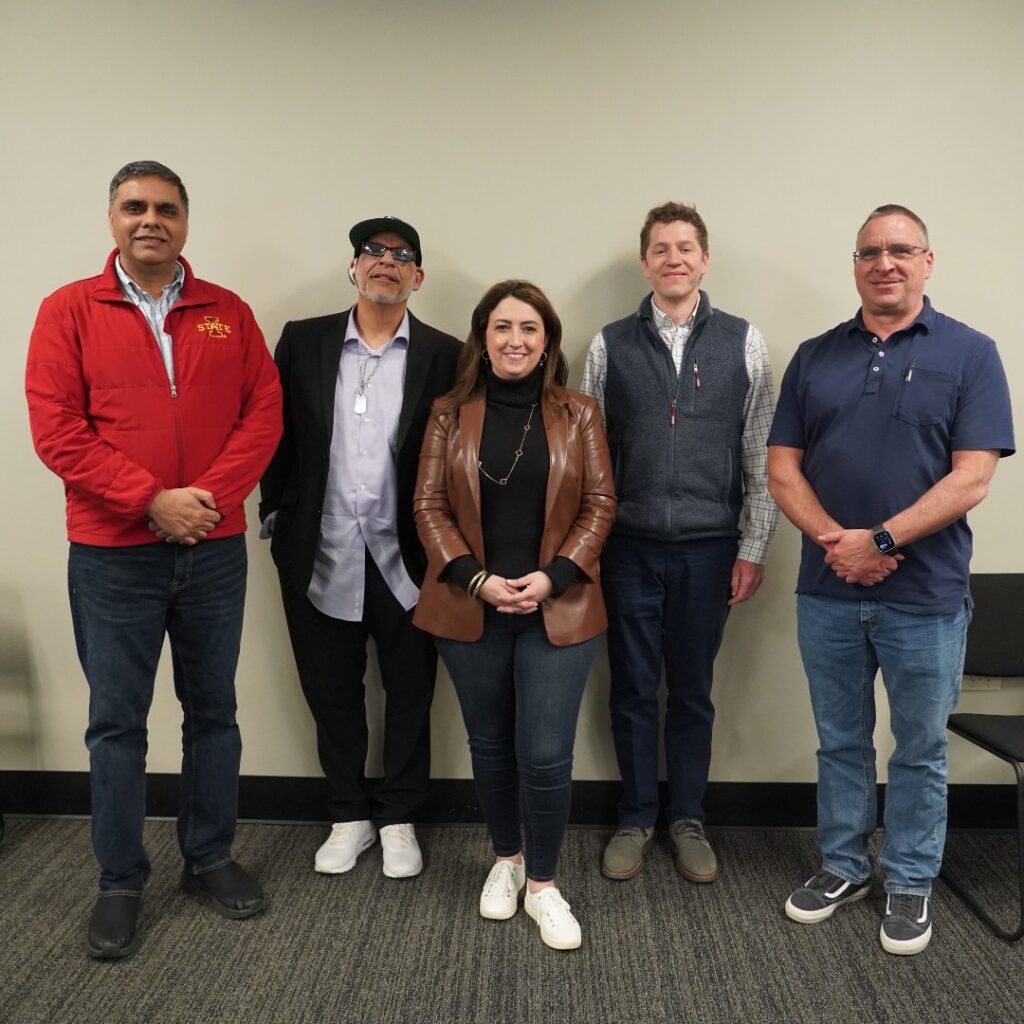
- Dr. Raj Agnihotri, PhD – Industry Engagement Dean, Iowa State University
- Donnie Burris – CEO, Burris Logistics
- Joe Negron – Owner, NGS Logistics
- Zach Buckner – CEO, Glyphic Software
- Donna Palumbo-Miele – Executive Director, Center for Supply Chain Research, Penn State
“Learning about all the creative and impactful ideas was fun, but what stood out most was the thoughtfulness behind each presentation,” shared Dr. Raj Agnihotri. “It was refreshing to see diverse teams from Data Science, Compliance, Carrier Development, and Operations come together. The experience was wholesome, and I appreciated the opportunity to be part of it.”
A Culture of Innovation Takes Root
The success of the first Week of Wonder reinforces Trinity’s commitment to cultivating a workplace where innovation is not only encouraged but expected.
“Week of Wonder was a perfect example of how collaboration, guided by the Working Genius framework, can turn ideas into real impact,” said Carlie Crouch, Senior Director of People Operations. “Seeing our Team Members challenge themselves and create solutions that will shape our future was truly inspiring. This is just the beginning.”
Trinity Logistics looks forward to making Week of Wonder an annual tradition by expanding its scope and continuing to drive meaningful innovation throughout the logistics industry.
LEARN ABOUT TRINITY'S LOGISTICS SERVICES DISCOVER TRINITY'S CAREER OPPORTUNITIESAbout Trinity Logistics
Trinity Logistics is a Burris Logistics Company, offering People-Centric Freight Solutions®.Our mission is to deliver creative logistics solutions through a mix of human ingenuity and innovative technology, enriching the lives of those we serve.
For the past 45 years, we’ve been arranging freight for businesses of all sizes in truckload, less-than-truckload (LTL), warehousing, intermodal, drayage, expedited, international, and technology solutions.
We are currently recognized as a Top Freight Brokerage by Transport Topics, a Green Supply Chain Partner by Inbound Logistics, and holds a silver sustainability rating by EcoVadis.
With core focus areas in Health and Wellness, Community Necessities, and Youth Leadership, this past year the Trinity Foundation proudly served and supported communities and causes that are close to our hearts.
Before diving into another exciting fiscal year full of fresh goals, we first wanted to first reflect on all we’ve recently done! In this past year alone, we’ve raised and donated over $61,831 and logged more than 3,000 volunteer hours.
Let’s dive into some of the highlights of this past year and celebrate all the incredible work from our Team as well as the generosity of our supporters.

HEALTH AND WELLNESS

Encouraging healthier lifestyles and better access to wellness resources is a cornerstone of the Trinity Foundation mission. Here’s how we made strides in this area:
Big Pink Volleyball Fundraiser
This energetic and meaningful annual event raised $6,200 this past year and benefited TidalHealth’s Drive for Mobile Mammography.
Blood Drives
Hosted by both our Delaware and Kansas City offices, our drives helped save lives in collaboration with the Blood Bank of Delmarva and the Community Blood Center.
Rock Your Socks
In honor of World Down Syndrome Day, all Trinity locations joined in on the celebration.
Company-Wide Encouragement
Small things add up. Through events like seasonal walking challenges, with over eight million steps logged, healthy snack offerings that fund the Trinity Foundation initiatives, and vision board classes, Trinity’s Team Members are encouraged to put their health and wellness at the forefront.

COMMUNITY NECESSITIES

We aim to improve and strengthen our local communities through investments and donating to those in need. Here’s how we upheld this commitment:
Hydration Drives
Our Scottsdale location donated 25 cases of water to support Salvation Army’s 2024 Heat Relief Campaign, while our Kansas City office participated in the Wings 4 Water event, raising over $700.
Wreaths Across America
Our Kansas City Team holds several in-office fundraising events to donate wreaths and honor our veterans.
Supporting Women
Our Texas office donated 10 welcome baskets filled with essentials and encouragement to the Refuge for Women organization, a transitional housing program for women recovered from trafficking.
Habitat for Humanity
2024 was our first year hosting a build day with 16 Team Members volunteering their time to roll up their sleeves and help build a brighter future for those in need. We’re hosting another volunteer day before the end of the fiscal year, too, and looking forward to making this a regular occurrence.
Sandwiches For the Homeless
Our Texas Team continues to prepare and donate sandwiches monthly to the homeless community through local organization, Love & Light Ministries.
Holiday Help
Through our annual Trinity Foundation events, Thanksgiving for All and Christmas Families, we were able to give out 300 Thanksgiving meal boxes and support 25 kids for Christmas, gifting them a couple outfits, a coat, hat, gloves, shows, and a few toys. We partner with Love Inc. who helps get us lists of names from local communities and schools.

YOUTH LEADERSHIP
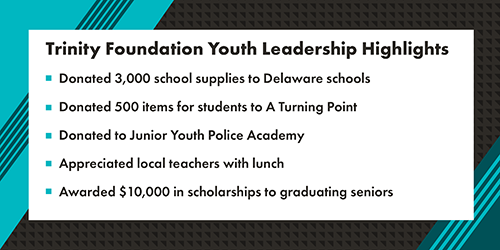
We wish to aid in the growth of leadership and build a future of strong community members by supporting our youth and promoting continued education. We did this through:
Donating School Supplies
Our Delaware office collected and donated over 3,000 school supplies to four local Delaware schools, with a special shout-out to the support of local businesses, Barton’s Rental Supply and I.G. Burton Auto. Trinity’s Kansas City location collected over 500 items for students and donated them to A Turning Point nonprofit to distribute.
Support the Youth Police Academy
Our Delaware Team Members donated funds to the Seaford Police Department’s Junior Youth Police Academy to help provide uniforms and training.
National Teacher Appreciation Week
The Delaware office delivered lunch to the hardworking educators at a local school.
Scholarships
Four Servant Leader Scholarships and one Make It Happen Scholarship, each worth $2,500, were awarded to local graduating seniors exemplifying leadership and service.

RAISING GREEN THROUGH OUR LARGEST FUNDRAISING EVENT

Our largest annual fundraiser, a tradition since 2005, takes place every fall and helps us achieve all the great efforts previously mentioned.
Trinity Team Members and any local participants can sign up to compete in the golf tournament, held at Heritage Shores in Bridgeville, Delaware. 2025’s event is coming up in October 2nd. For information and to sign up, please email [email protected].
AN EVER-GROWING PARTNERSHIP WITH LOVE INC
One relationship we’d like to acknowledge this year is our long-standing relationship with Love Inc of Mid-Delmarva that continues to grow. We’ve been working with this organization for quite a long time – so long that no one truly knows just how far back it goes!
From early on, they’ve helped us arrange and hold food drives, assist and volunteer with Cold Purple shelters, and so on. Eventually, our relationship grew to hosting two annual fundraising events with them – our Thanksgiving for All and Christmas Families efforts.
In July 2024, we took our relationship a step further by donating a car and $5,000 to support them in their operations and individual efforts of connecting people in Delmarva with the resources they need.
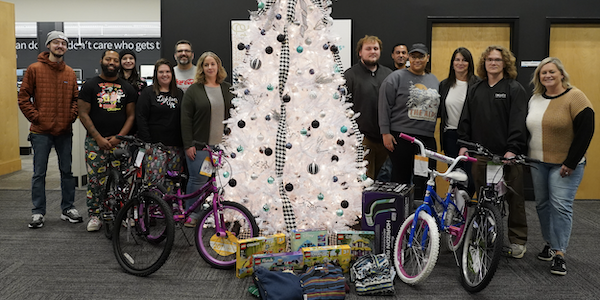
LOOKING AHEAD
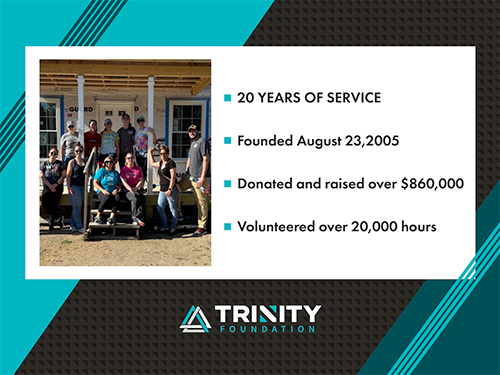
As we wrap up another impactful year, we’re filled with gratitude for our Trinity Team Members, community partners, and every supporter that has walked alongside us. Since our founding 20 years ago on August 23, 2005, we’ve raised and donated over $860,000 and volunteered over 20,000 hours – and we’re not stopping anytime soon!
Here’s to another year of giving back, growing strong, and getting even more of our Team Members involved in making a difference.
Stay connected with the Trinity Foundation by following us on Facebook, joining our fundraising events, and helping us expand our reach.
Know someone in need or a cause that could use support? Send them our way – we’re always looking for new ways to serve.
Get Involved Stay Connected with Trinity – Join Our Email List Follow Us On FacebookStay up to date on the latest information on conditions impacting the freight market, curated by Trinity Logistics through our Freightwaves Sonar subscription.
Exit Stage Left
The slow but consistent exit of carriers from the freight market continues.
Figure 1.1 shows a theme of negative net authorities in the for-hire carrier market thus far in 2025. This continues the trend from last year, when there were 13,000 fewer carriers in the market at the end of the year versus compared to the start, an almost four percent decrease. Operating costs, tariff-related increases in equipment and parts, and a stricter mandate on driver proficiency in English will continue to negatively impact the number of drivers and carriers in the market.
Where this impact will be most pronounced is the tender rejection rate, the frequency in which carriers say “no thank you” to a shipment offered to them. I don’t foresee the rejection rates we experienced in the latter part of ’20 and all of ’21, which were in the 20-30 percent range, happening. However, we are quickly approaching double-digit rejection rates which would signal a more balanced supply and demand freight market.
Shippers have been working with the luxury of not having to reach too far into their routing guides and carrier and broker partners. As the recent trends continue, freight acceptance compliance will become more challenging for them.

West Coast Ports Heat Up Again
The one thing that is somewhat unpredictable right now is import volumes and their impact on the freight market.
Figure 2.1 shows the slowdown of freight from overseas, most of which affected our West Coast ports. Once a handshake deal was in place to stave off steep tariffs with China, ships pulled up their anchors and chugged across the waters destined for the U.S.
Import volumes have recently surpassed 2023 levels and are soon to close in on 2024 volumes. Most of this freight will be more of a “just in case” scenario versus “just in time”. This will see a greater benefit to the rail industry versus truckload market, as freight that is not time sensitive has the luxury of taking longer to arrive at its destination at a lower cost.
Expect to see some volatility in truckload pricing in and around the LA/LB ports as capacity and freight volume imbalances collide.

Stay Up To dAte
Looking for a more frequent update? Subscribe to our newsletter and receive the top five logistics articles of the week every Friday morning by selecting “Weekly News Update” when you select your preferences.
Get Weekly News Updates in Your InboxAt a recent discussion panel, conversations with peers had me thinking about technology’s role in improving customer experience. More business impact than ever before is driven by technology. The landscape of customer experience is no exception.
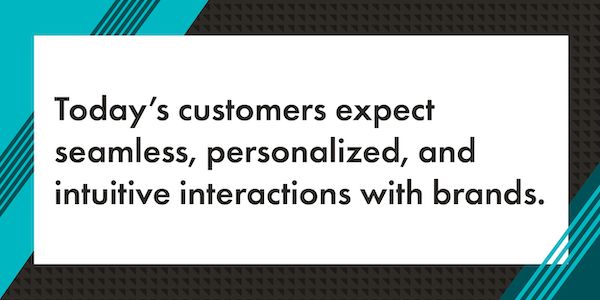
Today’s customers expect seamless, personalized, and intuitive interactions with brands. A crucial role in meeting these demands is held by technology leaders, such as myself. From AI chatbots to advanced self-service tools, businesses look to technology to improve efficiency and create more meaningful customer experiences.
Yet, as technology improves customer experience, it also presents new challenges. How do you get closer to what customers want without crossing the line?
Balancing Personalization vs Privacy
One of the biggest challenges organizations face today is finding the balance between personalization and privacy concerns. While we all love when a company “gets us”, however, data collection can make people feel uneasy.
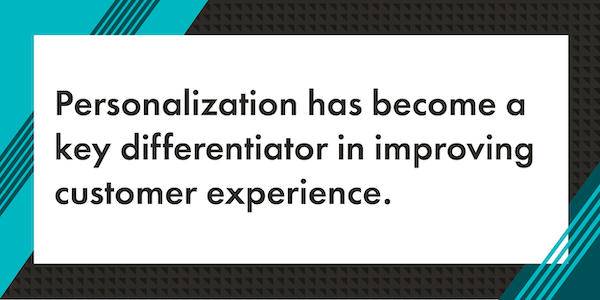
Customers expect companies to understand their preferences AND deliver relevant, timely service. Personalization has become a key differentiator in improving customer experience, leading to higher satisfaction, loyalty, and conversion.
However, personalization relies heavily on accurate data collection. Companies must gather and analyze vast amounts of data to create tailored experiences both from internal sources and third-party data sources. This raises questions and brings privacy and cybersecurity concerns to the forefront. No one wants to be the company responsible for leaking your information.
To navigate these challenges, organizations need to:
Adopt Transparency and Consent Practices
Customers need to trust that their data is being handled responsibly. Transparency builds trust so share how their data gets collected, stored, and used. Giving customers control through clear consent processes can foster better relationships.
Focus on Data Minimization
Only collect the data that’s necessary for improving customer experience. This helps customers feel more at ease and comfortable engaging with the brand. As a bonus, it also helps limit exposure to potential breaches.
Invest in Secure Data Management
Robust data encryption, secure access controls, and regular audits are critical to protect against data breaches.
Master Accuracy
Companies must use more resources around the validation of the data collected. Delivering information and analysis is great, but only if the backing data is accurate.
Don’t Be Creepy
Collecting information is extremely helpful in improving customer experience through personalization. However, it’s important to train the people (and manage the scripts of AI) that leverage this information. There’s a fine line between coming across as knowing the person and them thinking you have a webcam in their house.
Striking the right balance between privacy and personalization requires organizations to align in their customer experience strategies. Regulatory frameworks and ethical data practices are essential.

Improving Customer Experience With Self-Service Tools
As improving customer experience becomes critical for organizations, there’s an increasing push to empower business users.
Not long ago, even small customer-facing changes needed collaboration with IT or development teams. This caused bottlenecks, slowing down innovation and responsiveness.
Today, customer experience management is accessible to everyone with the rise of self-service tools.
One of the most significant trends is the adoption of no- and low-code platforms. Business users can now build, customize, and deploy customer experience solutions. This includes creating workflows for customer support, automating routine tasks, and personalizing customer journeys.
Now, even non-technical teams can take a more direct and hands-on approach.
Key benefits of these tools include:
Faster Iteration
Business users can quickly adapt to customer feedback, market changes, or business needs without waiting for developer intervention. This allows for more agile and responsive customer experience management.
Less IT Dependence
With customer experience teams able to design and manage their own solutions, there’s less strain on IT departments. They’ll instead be able to focus on more complex, strategic projects.
Personalization at Scale
Internal teams can rapidly experiment with and launch new strategies. They can try segment-specific messaging or targeted promotions, without having to navigate lengthy timelines.
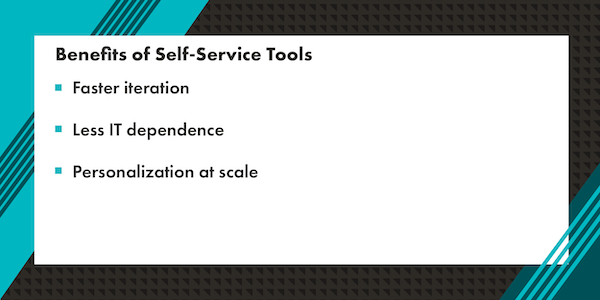
These tools empower business users, reduces dependence on technical teams, and accelerates innovation. Customer experience teams become better at adapting to changing customer needs and driving more personalized, data-driven experiences. While efficiency improves, organizations can also stay ahead in an increasingly competitive market.
But (there’s always a “but”, right?) these tools must be deployed with care, ensuring privacy, ethics, and security are baked in.
Guardrails and guidelines need to be established at the organizational level. They need to ensure only proper data is delivered to the intended recipients and that only approved methods of delivery are leveraged. Monitoring must also be in place so both the whole of the technology landscape is accounted for in security initiatives, scans, and that resilience of the solutions are maintained.
AI and Large Language Models in Customer Experience
One of the most transformative impacts in recent years is the availability of AI models like Large Language Models (LLMs). These systems can understand and generate human-like text and voice. Businesses can automate a variety of customer interactions with AI — from chatbots to virtual assistants.
LLMs have had a profound impact on customer experience in multiple industries:
Healthcare
AI-driven chatbots and virtual assistants can provide medical transcription, appointment management, and even symptom checking. It helps reduce the workload for all kinds of healthcare professionals – including my vet.
Banking
In the financial industry, AI-powered assistants help customers with account queries, transaction monitoring, and fraud detection. By offering faster, more accurate responses, these systems greatly improve customer experience. Except of course when they don’t. I recently got blocked from a cash withdrawal at an ATM about a mile from my house at a gas station I use quite often.
Travel and Hospitality
LLMs are also transforming the travel industry by helping customers book flights, hotels, and manage itineraries through highly personalized and conversational interfaces. But beware of the data being used. Getting routed to an attraction that’s closed that day, but didn’t update their website, can be quite annoying (cut to Woody Harrelson and Matthew McConaughey commercial for AI.)
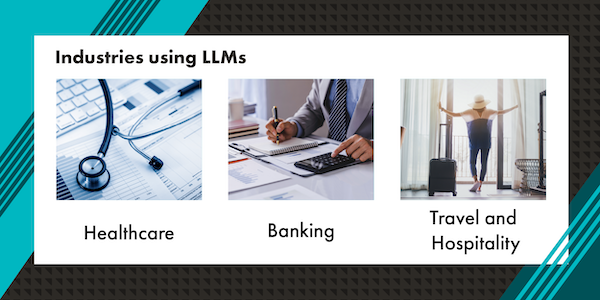
One major benefit? Less waiting and fewer unanswered calls. A close second? Reps having to repeat answers to previously asked, and answered, questions.
Personally, long hold times and calls going unanswered (including being sent to voice mail) are some of the more annoying parts of working with businesses. A system that always answers, even if it can’t meet every inquiry, is a major step to reducing friction – usually me rubbing the bridge of my nose while on hold.
Still, the human-like nature of these AIs raises new ethical questions. Call centers are a large source of employment for companies internationally. We must balance the use of these tools with the need to support our fellow humans and our collective need to fit into the current economic world structure (i.e. getting a paycheck). It’s a responsibility we all share.
Additionally, as LLMs rely on vast datasets to function, they raise concerns about bias. If not properly managed, they can unintentionally hold biases present in their training data. Different customer segments could receive unequal treatments. Regular auditing and fine-tuning of AI systems are essential to ensure they provide fair and equal customer experiences.
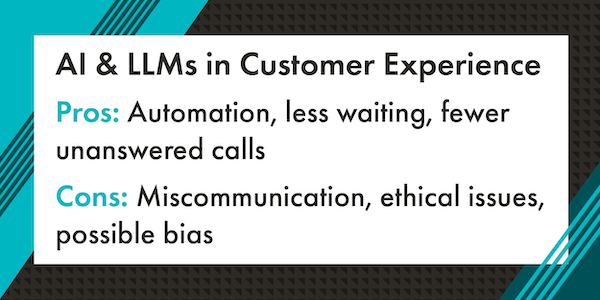
It’s Not Just About Technology – It’s About Trust
Technology has undoubtedly transformed how businesses are improving customer experiences, delivering personalization, scalability, and efficiency. But with it comes new challenges – particularly around privacy, fairness, and the ethical use of AI.
Organizations that successfully navigate these complexities — by investing in secure, transparent, and user-friendly systems — will be positioned to build trust, loyalty, and long-lasting customer relationships.
As technology leaders, it’s our responsibility to install these technologies and ensure they’re used ethically and effectively. Only then can we drive better outcomes for our customers, team members, and businesses alike.
The future of customer experience looks bright – if we continue to integrate advanced technologies with care, purpose, integrity, and most importantly, a focus on the people behind that data.
Get More Content Like This In Your InboxABOUT THE AUTHER

Russ Felker
Chief Technology Officer
For the past 30 years, Russ has been leading technology changes, not only as CTO, but also as a founder and technology advisor, creating technology solutions for business problems. He’s always had a passion for using technology to improve customer experience and help companies allow people to focus less on clicks and more on service.
Stay up to date on the latest information on conditions impacting the freight market, curated by Trinity Logistics through our Freightwaves Sonar subscription.
Freight in Retreat
A picture is worth a thousand words.
Figure 1.1 shows the initial impacts of the tariffs with regard to ocean containers and over-the-road trucking volumes. As you see by the yellow line, shippers were eager to get ahead of the pending tariffs with freight from China. But as the tit for tat trade war has continued, blank sailings and cancelled bookings are becoming common and has caused inbound container volume to trend downward, now sitting almost 20 percent less than this time last year.
This has translated into a regression in the over-the-road trucking volume, with the blue line starting to show a decline at time of year when freight volumes should be escalating with increased consumer activity and the start of produce season. Additionally, the lack of container volume has an impact on rail activity with total intermodal container volume receding five percent from where it was in March.

Carriers Struggle with Freight Shift
The rejection of freight tenders (OTRI.USA) has been relatively unchanged over the past month plus. This has been held up by a declining base of carriers. However, if you look at Figure 2.1 you will see via the red line that the average length of haul for shipments has been on a steady decline pretty much for the past year.
Yes, less import traffic plays into that, as those shipments typically head to larger metro areas (Chicago, Dallas) once they cross into our borders at the port. But a push for regionalization by shippers and an increase in e-commerce activity has also fueled more frequent but shorter distances for freight to travel, down about 12 percent from this time in 2024.
This is not great news for carriers as 75 miles less equates to a lower price they can command, but the mileage difference is not enough to allow them to compensate for the difference by additional freight moves during their work week.
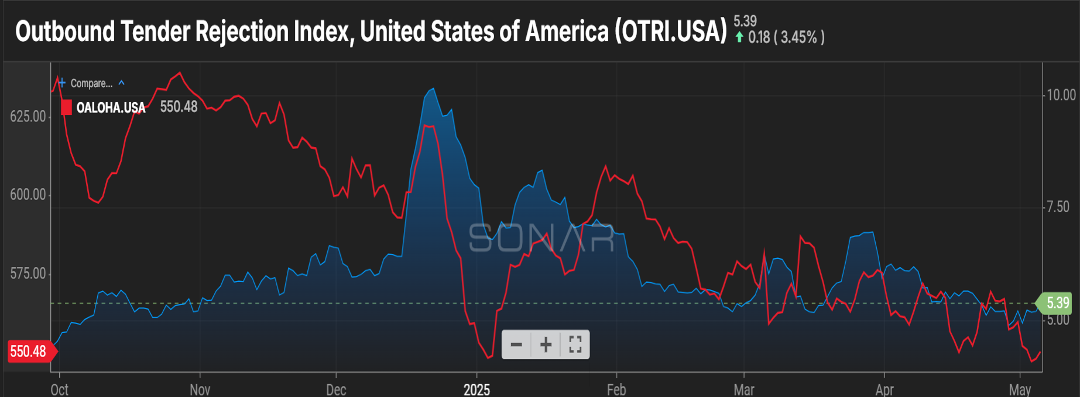
Tariffs Price Out Small Carriers
The length and severity of the tariffs is not only having an immediate impact on trucking volumes, but it could be setting the industry up for a capacity shortage once calmer waters prevail. 25 percent tariffs on Mexican and Canadian imports have increased the cost of new trucks by almost $30,000, making it particularly challenging for smaller carriers to invest in new equipment, let alone new entrants to enter the carrier capacity market.
And for those looking to stretch the mileage out of older equipment, the increased cost for maintenance parts and fuel additives as a result of tariffs puts further strain on already tight budgets. Considering 93 percent of the for-hire carriers in the U.S. are less than 10 trucks, there could be a gaping hole to fill in the spot market when a freight rebound happens.
Stay Up To dAte
Looking for a more frequent update? Subscribe to our newsletter and receive the top five logistics articles of the week every Friday morning by selecting “Weekly News Update” when you select your preferences.
Get Weekly News Updates in Your InboxYou might be thinking, “Do I really need a transportation management system? I don’t feel like our process is necessarily broken. Is it really worth it? Is my company truly ready for one?” Yet, what if you could strategically reduce your overall logistics spend while transforming your team from being reactive and task-oriented to proactive and customer-oriented? What kind of impact would that have on your company’s bottom line?
That’s exactly what I’m here to help you answer. Here are five signs that I always see when a business is ready to take the next step and invest in a transportation management system.
Let’s dive in.
SIGN 1: Your Business Meets Any of These Qualifications
There can be some not-so-subtle signs that a business is ready to invest in a transportation management system. If your business
- has a freight spend of $1M or more,
- utilizes a mix of transportation modes,
- has multiple locations that utilize their own mix of broker and asset providers,
- procures a majority of freight via the spot market, or
- manages most of your data via Excel spreadsheets;
then consider yourself qualified! There can also be some more subtle signs…
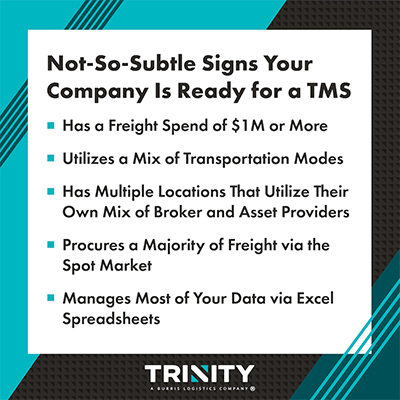
SIGN 2: A LACK OF EFFICIENCY
A lack of efficiency in your business directly results from a decentralized and very manual approach. Programs like Outlook and Excel were just never intended to handle a freight spend of $1 million or more. If your freight spend is $1 million or more, you’re probably working with a couple of hundred orders a month, with who knows how many stakeholders to help micromanage quotes, tenders, tracking, and tracing of shipments.
If you’re questioning whether your company has a lack of efficiency, ask yourself:
- How much time is being wasted across your organization with overwhelming manual processes?
- Does this process save you any money when it comes to freight spend?
- Do you know if you are utilizing the right carriers?
- Would contract pricing cost you less than the spot market in the long run?
The bottom line is this is a reactive strategy focused on individuals’ tasks. To optimize your team and freight, you need a major shift towards being more proactive and customer-focused.
This is where Trinity’s transportation management system (TMS) can help you. All our Managed Transportation features a cloud-based TMS platform that creates a centralized freight command center, replacing your redundant manual processes with automation.
Our TMS helps you manage the entire life cycle of an order and we can even integrate with your order management system to truly optimize your workflow. This means no more phone calls, typing out shipment details, or wondering where your freight is or when it’s going to deliver. Technology is one of the critical aspects of our solutions here at Trinity and also a major catalyst to transforming your supply chain.
SIGN 3: SEEKING IMPROVED PERFORMANCE
Efficiency isn’t just about getting faster; it’s about getting better – creating better team performance, better carrier performance, and ultimately improving your bottom-line company performance.
Is there room for improvement in these areas for you? Are your current strategies effective? Can they be measured? You may have answers to these questions that vary from location to location. You’ll usually find some of your distribution centers are better at procuring freight than others.
While a siloed strategy may have made sense for you at one point, companies grow and change. Considering change is a constant, a more wholistic approach will typically yield a better overall cost and carrier performance for you. This is what we consider to be the process part of our solutions. Data is a key driver for the strategy on this one.
On the surface level, it will appear that you simply are spreading your freight too thin across too many carriers or brokers. At Trinity, our Team of Logistics Consultants can quickly diagnose if you are leveraging your overall volumes to the best of your ability. Through strategic sourcing and customer-specific pricing, you can yield six to ten percent savings, sometimes even more. It can also have a significant effect on improving on-time performance.
Best of all, with Trinity’s Managed Transportation, you’ll always be able to track these metrics. You’ll be able to know exactly how your teams compare to the market and are able to adapt quickly when things change.
SIGN 4: LACKing VISIBILITY
It’s hard to overstate the importance of real-time visibility in today’s supply chain.
When a customer or sales rep asks for a delivery ETA or if the warehouse needs to know what trucks are scheduled to come in; that can all fall back on your outdated and manual processes. Things like picking up the phone, back and forth emails, creating and sharing spreadsheets, that’s just your day-to-day visibility.
What about those overall performance metrics and being able to measure your team or your carriers? Unfortunately for many shippers, there can be too many roadblocks for effective communication and a lack of overall supply chain awareness.
However, with the right strategy and technology, visibility can shift from a challenge to a strength. Having access to a transportation management system takes over a lot of the heavy lifting for you, acting as a virtual control tower for all logistics updates and communication.
With Trinity’s solutions, we included unlimited users who can access updates and data 24/7 via the cloud. We can even create push notifications where your team, your warehouse, and your customers can receive updates for their specific tasks automatically. For most shippers, real-time visibility has fully transitioned from an optional benefit to a business necessity – which is why Trinity brings all of this valuable information right to your fingertips.
SIGN 5: needing BUSINESS INTELLIGENCE
Data has quickly become one of the world’s most valuable resources. In order to make effective decisions, proper data and analysis are needed, especially for logistics strategy or more enterprise-level decisions that reach far beyond the supply chain.
Now let’s say you do have access to good, tangible data. Even still, most likely your data is spread out among various laptops, email accounts, and carrier portals. Trying to compile complete and accurate information is difficult in itself this way, but the greater challenge is what can you do with this data?
That’s where working with Trinity Logistics comes in hand. We help compile and present a key analysis in a way that is easy for you to understand and collaborate on action steps for your company’s continuous improvement. Our customers are able to successfully leverage their data to lower costs, improve performance, and drive their company forward. There are many types of helpful reports you can expect to see such as carrier scorecards, customer profitability reports, to network analysis, and distribution projects.
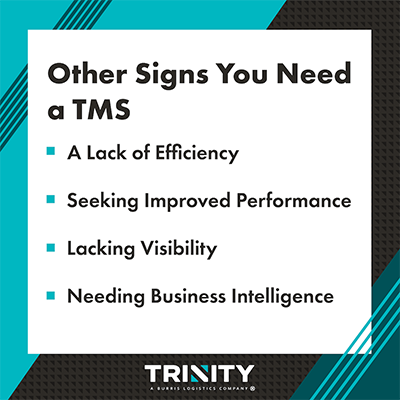
take your business From Surviving to Thriving
So, are the your company’s signs pointing in the direction of a transportation management system?
If it’s looking like it may be the right time for your company to invest in solid logistics technology, then it’s time for your next step – finding the right provider. I understand you have a lot of options, but I’d like to recommend checking out Trinity’s Managed Transportation solutions.
Our solutions are completely customizable, but each comes with a cloud-based TMS, offering a wide range of capabilities to take over as your entire logistics toolbox:
- Order entry
- Tracking & notifications
- Reporting
- Load planning
- Document management
- Claims management
- Freight auditing and payment
- System integration
- Rating, tendering, and routing guide
Now, don’t just take my word – here’s what Ben at cfm Distributors Inc. had to say about working with Trinity’s Managed Transportation solution:
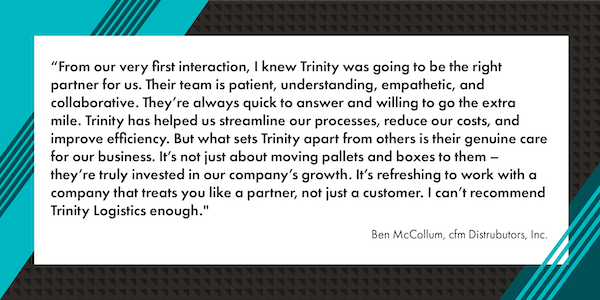
The best part of checking out Trinity for your future transportation management system? Your consultation is completely FREE and you’ll walk away with the knowledge about how your business can operate more efficiently and strategically with Trinity Logistics’s support. What do you have to lose?
Request a FREE TMS ConsultationNot quite ready for a consultation but still interested in learning more about Trinity’s TMS? Register for a brief demo of our TMS.
Schedule a FREE TMS DemoStay up to date on the latest information on conditions impacting the freight market, curated by Trinity Logistics through our Freightwaves Sonar subscription.
tarifFS AND TIGHT WALLETS
A colleague of mine told me recently that anytime you give a presentation around technology, there is an obligation, almost a duty, to include “AI”. Now, it feels like anytime you talk or write about things in the freight market, you have to include the word “tariffs”. The old saying, if you don’t laugh, you’ll cry seems very appropriate.
In 2024, 68 percent of personal consumer expenditures comprised our nation’s gross domestic product (GDP). This is concerning when you look at the trend over the last three months regarding consumer revolving credit.
As you can see below in Figure 1.1, year-over-year (YoY) there has been a decline. When customers feel skittish about taking on a new car loan or signing on the dotted line for a thirty-year mortgage, this has a trickle-down effect, not just on the immediate sectors, like the auto industry and housing, but those secondary and tertiary markets. If the pace of new homes being bought slows, then production of things that go into the home, like furniture, carpet, or fixtures, is also impacted negatively.
Some have pointed to the credit card revolving debt as a sign of the economy’s strength. That may have been a valid argument in January, when we saw a six percent YoY gain. But the recent report shows an annualized bump of only 0.1 percent, indicating that consumers are curtailing spending and relying on cash at hand to fund purchases versus credit cards.
Don’t be surprised if long-term debt, like auto loans, starts to show an uptick in delinquency.

Tiny Shifts, but Big Waves
As the threat of the “T” word continues, the freight market continues to see the pull forward of goods entering the U.S. as shippers look to get ahead of an increase in production costs.
While a slight increase in port areas like Los Angeles may seem like no big deal (Figure 2.1), keep in mind over half of the import volume funnels through the LA/LB ports. Even going from a 2.5 percent rejection rate to now in the five percent range (yellow line) may not seem significant. However, when you apply that change to 413k shipments in February alone, it becomes a significant impact.
A port like Savannah (blue line) shows the impact of a fragile capacity balance, and even a slight uptick can be needle moving for rejection of freight tenders. While not to the size of the LA/LB ports, handling 265k import containers in March, a surge in volume of 30k containers compared to February 2025, an imbalance in capacity can quickly escalate rejection rates close to 15 percent as they stand currently.

Stay Up To dAte
Looking for a more frequent update? Subscribe to our newsletter and receive the top five logistics articles of the week every Friday morning by selecting “Weekly News Update” when you select your preferences.
Get Weekly News Updates in Your InboxTrinity Logistics, a leading third-party logistics provider (3PL), is excited to announce its ranking on Transport Topics’ prestigious Top Freight Brokerages list. This year, Trinity is ranked number 24, continuing its strong presence within the logistics industry.
Transport Topics is a leading publication within the transportation sector and conducts annual rankings of freight brokerage firms. The ranking is determined based on gross revenue for the most recent 12-month period, highlighting Trinity’s sustained growth and impact in the freight brokerage sector. As the logistics landscape continues to evolve, Trinity’s ability to secure a top spot on this list speaks to the company’s dedication to delivering high-quality, reliable logistics solutions.
“We are incredibly proud to be recognized once again as a top freight broker by Transport Topics. Thanks to the continued dedication and commitment of our entire Team, this marks our 23rd year on the list!” said Sarah Ruffcorn, President of Trinity Logistics. “This recognition highlights our ability to serve our Shipper and Carrier customers with excellence through the Trinity Experience. Thank you to Transport Topics for honoring us, and for the continued trust of our Shipper and Carrier relationships.”
As the company continues to thrive, Senior Vice President Mark Peterson at Trinity Logistics expressed immense pride in the Team’s dedication and the ongoing success that earned them this recognition.
“I’m incredibly proud of the Trinity Team,” said Peterson, SVP of Sales and Marketing at Trinity Logistics. “Their dedication and hard work are the driving force behind our success. This recognition is a testament to their commitment to delivering exceptional service and consistently going above and beyond for our customers.”
Trinity’s success is driven by its strong, customer-focused Team, committed to simplifying logistics and providing creative, People-Centric Freight Solutions ®.
In addition to making Transport Topics top Freight brokerages, Trinity has also made the Top 100 Logistics Companies list!
Trinity is honored to receive this recognition and continues to provide outstanding solutions and service to the logistics industry.
LEARN ABOUT TRINITY'S LOGISTICS SERVICESAbout Trinity Logistics
Trinity Logistics is a Burris Logistics Company, offering People-Centric Freight Solutions®.Our mission is to deliver creative logistics solutions through a mix of human ingenuity and innovative technology, enriching the lives of those we serve.
For the past 45 years, we’ve been arranging freight for businesses of all sizes in truckload, less-than-truckload (LTL), warehousing, intermodal, drayage, expedited, international, and technology solutions.
We are currently recognized as a Top Freight Brokerage by Transport Topics, a Green Supply Chain Partner by Inbound Logistics, and holds a silver sustainability rating by EcoVadis.
Trinity Logistics, a leading, nationwide third-party logistics provider (3PL), is proud to announce the hiring of Chad Schilleman as Vice President of Drayage Services. This addition to Trinity Logistics’s Team underscores the company’s commitment to providing industry-leading drayage services with an emphasis on innovation, efficiency, and exceptional client support.
With over 20 years of experience in logistics, including drayage, intermodal, and supply chain operations, Schilleman brings a proven track record of success and a visionary approach to Trinity’s drayage solutions.
Schilleman’s impressive career began with the founding of BCM Logistics, which he grew into a thriving business before its acquisition by Watco. At Watco, he spearheaded a robust intermodal program and implemented technology-driven solutions, showcasing his ability to drive innovation and optimize supply chain efficiency. Throughout his career, he has excelled in management container transport, supply chain optimization, and overall, guiding businesses toward logistical success.
Amy Proctor, Senior Vice President of Logistics Solutions at Trinity, expressed her excitement for Schilleman’s arrival, saying, “With his expertise and vision, Chad will play a pivotal role in driving growth, fostering client relationships, and optimizing our drayage operations. His leadership style and commitment to excellence align with our values and mission, and we are confident that he will make a significant impact. I look forward to the exciting contributions he will bring to our Team.”
Chad shared his enthusiasm for this new role, stating, “I am excited to join Trinity Logistics and contribute to the company’s growth and success. Trinity’s commitment to fostering a positive and collaborative culture aligns perfectly with my own values. By focusing on our ‘why’ – delivering exceptional service and creating value for our customers – we can inspire and drive meaningful change within the industry. I look forward to working with the talented Team at Trinity and leveraging my experience to enhance our drayage services and deliver value to our customers.”
Trinity Logistics wishes Schilleman a warm welcome as he embarks on this new chapter with the company.
LEARN ABOUT TRINITY'S LOGISTICS SERVICESAbout Trinity Logistics
Trinity Logistics is a Burris Logistics Company, offering People-Centric Freight Solutions®.Our mission is to deliver creative logistics solutions through a mix of human ingenuity and innovative technology, enriching the lives of those we serve.
For the past 45 years, we’ve been arranging freight for businesses of all sizes in truckload, less-than-truckload (LTL), warehousing, intermodal, drayage, expedited, international, and technology solutions.
We are currently recognized as a Top Freight Brokerage by Transport Topics, a Green Supply Chain Partner by Inbound Logistics, and holds a silver sustainability rating by EcoVadis.